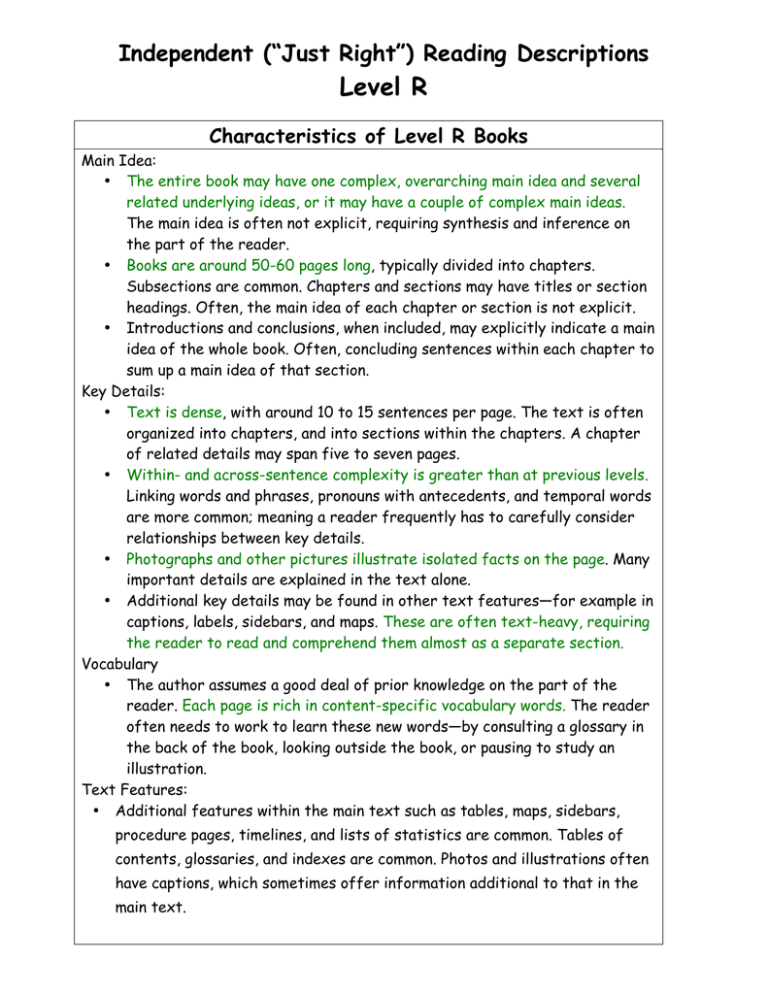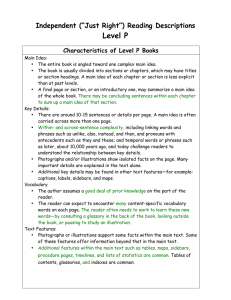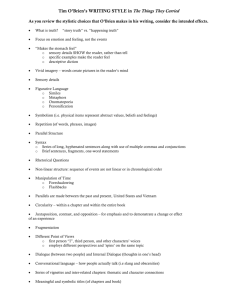Level R Independent (“Just Right”) Reading Descriptions Characteristics of Level R Books
advertisement

Independent (“Just Right”) Reading Descriptions Level R Characteristics of Level R Books Main Idea: • The entire book may have one complex, overarching main idea and several related underlying ideas, or it may have a couple of complex main ideas. The main idea is often not explicit, requiring synthesis and inference on the part of the reader. • Books are around 50-60 pages long, typically divided into chapters. Subsections are common. Chapters and sections may have titles or section headings. Often, the main idea of each chapter or section is not explicit. • Introductions and conclusions, when included, may explicitly indicate a main idea of the whole book. Often, concluding sentences within each chapter to sum up a main idea of that section. Key Details: • Text is dense, with around 10 to 15 sentences per page. The text is often organized into chapters, and into sections within the chapters. A chapter of related details may span five to seven pages. • Within- and across-sentence complexity is greater than at previous levels. Linking words and phrases, pronouns with antecedents, and temporal words are more common; meaning a reader frequently has to carefully consider relationships between key details. • Photographs and other pictures illustrate isolated facts on the page. Many important details are explained in the text alone. • Additional key details may be found in other text features—for example in captions, labels, sidebars, and maps. These are often text-heavy, requiring the reader to read and comprehend them almost as a separate section. Vocabulary • The author assumes a good deal of prior knowledge on the part of the reader. Each page is rich in content-specific vocabulary words. The reader often needs to work to learn these new words—by consulting a glossary in the back of the book, looking outside the book, or pausing to study an illustration. Text Features: • Additional features within the main text such as tables, maps, sidebars, procedure pages, timelines, and lists of statistics are common. Tables of contents, glossaries, and indexes are common. Photos and illustrations often have captions, which sometimes offer information additional to that in the main text. Characteristics of Readers at Level R • • • • • • • • • • Can remember information in summary form over chapters, a series of short stories, or sequels in order to understand larger themes (&report in organized way) Make connections between characters in different texts (setting, problem, person) Can explain how an author supports particular points in a text Will vary the pace of reading, as needed; will form questions & search for answers Can read and understand the connotative meaning of words, and when words are used figuratively; can add new and interesting words to his/her vocabulary Can process texts with dense print Can solve complex multisyllable (3+) words (vowels, phonograms, affixes, etc) Can identify and use words with multiple meanings, or difficult proper nouns Can infer characters’ feelings/motivations, using cause/effect, dialogue, or what other characters say about them; can manage multidimensional characters Can take unfamiliar perspectives when interpreting about characters Sample Texts - Level R All-Star Examples: The Hindenburg Disaster by Peter Benoit Everything Dog by Marty Crisp The Great Kapok Tree by Lynne Cherry Forest Mammals by Bobbie Kalman Glorious Days, Dreadful Days: The Battle of Bunker Hill by Philippa Kirby A Book About Planets and Stars by Betty Polisar Reigot You Wouldn’t Want to Be an Egyptian Mummy! Disgusting Things You’d Rather Not Know by David Stewart Caught With a Catch: Poaching in Africa by Laura Layton Strom The Digestive System by Christine Taylor-­‐Butler Immigrants: Coming to America by Gare Thompson Caves by Jenny Wood




